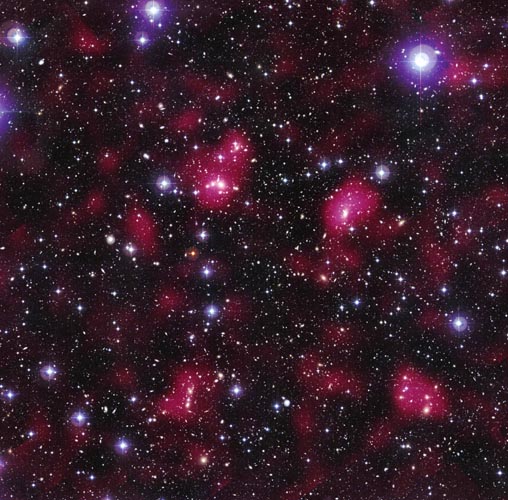
Caught in the Cosmic Dark Matter Web
Description: Space Telescope A901/902 Galaxy Evolution Survey (STAGES)
Position (J2000): The STAGES area spans a quarter square degree centered on the Abell 901/2 supercluster at roughly R.A. = 10h and Dec. = -10
Constellation: Leo
Dimensions: Greater than 16 million light-years across
Distance: 2.6 billion light-years
Instrument: ACS/WFC
Exposure Date(s): June and July, 2005
Exposure Time: 1.6 days
Image Credit: NASA, ESA, C. Heymans (U of British Columbia),
M. Gray (U of Nottingham), and the STAGES Collaboration
Release Date: January 10, 2008
ABOUT THIS IMAGE:
This image reveals the distribution of dark matter in the supercluster Abell 901/902, composed of hundreds of galaxies. Astronomers assembled this photo by combining a visible-light image of the supercluster taken with the MPG/ESO 2.2-meter telescope in La Silla, Chile, with a dark matter map derived from observations with NASA's Hubble Space Telescope.
The magenta-tinted clumps represent a map of the dark matter in the cluster. Dark matter is an invisible form of matter that accounts for most of the universe's mass. The image shows that the supercluster galaxies lie within the clumps of dark matter.
Hubble cannot see the dark matter directly. Astronomers inferred its location by analyzing the effect of so-called weak gravitational lensing, where light from more than 60,000 galaxies behind Abell 901/902 is distorted by intervening matter within the cluster. Researchers used the observed, subtle distortion of the galaxies' shapes to reconstruct the dark matter distribution in the supercluster. The image was assembled by combining a visible-light image of the supercluster with a map of the dark matter distribution.
The dark matter map was constructed by measuring the distorted shapes of over 60,000 faraway galaxies. To reach Earth, the galaxies' light traveled through the dark matter that surrounds the supercluster galaxies and was bent by the massive gravitational field. Astronomers used the observed, subtle distortion of the galaxies' shapes to reconstruct the dark matter distribution in the supercluster using a method called weak gravitational lensing. The dark matter map is 2.5 times sharper than a previous ground-based survey of the supercluster.
The Hubble study pinpointed four main areas in the supercluster where dark matter has pooled into dense clumps. These areas match the location of hundreds of galaxies that have experienced a violent history in their passage from the outskirts of the supercluster into these dense regions. The four close-up images flanking the central photo are Hubble views of the four dense clumps of matter. To make this image, astronomers superimposed the dark matter map over a Hubble visible-light image of the supercluster galaxies.
The images are part of the Space Telescope Abell 901/902 Galaxy Evolution Survey (STAGES), which covers one of the largest patches of sky ever observed by the Hubble telescope. The area surveyed is so wide that it took 80 Hubble images to cover the entire STAGES field. The new work is led by Meghan Gray of the University of Nottingham in the United Kingdom and Catherine Heymans of the University of British Columbia in Vancouver, along with an international team of scientists.
The Hubble study pinpointed four main areas in the supercluster where dark matter has pooled into dense clumps, totaling 100 trillion times the Sun's mass. These areas match the location of hundreds of old galaxies that have experienced a violent history in their passage from the outskirts of the supercluster into these dense regions. These galaxies make up four separate galaxy clusters
The STAGES survey's simultaneous focus on both the big picture and the details can be likened to studying a big city. "It's as if we're trying to learn everything we can about New York City and New Yorkers," Gray explained. "We're examining large-scale features, like mapping the roads, counting skyscrapers, monitoring traffic. At the same time we're also studying the residents to figure out how the lifestyles of people living downtown differ from those out in the suburbs. But in our case the city is a supercluster, the roads are dark matter, and the people are galaxies."
Further results by other team members support this view. "In the STAGES supercluster we clearly see that transformations are happening in the outskirts of the supercluster, where galaxies are still moving relatively slowly and first feel the influence of the cluster environment," said Christian Wolf, an Advanced Research Fellow at the University of Oxford in the U.K.
Assistant professor Shardha Jogee and graduate student Amanda Heiderman, both of the University of Texas in Austin, concur. "We see more collisions between galaxies in the regions toward which the galaxies are flowing than in the centers of the clusters," Jogee said. "By the time they reach the center, they are moving too fast to collide and merge, but in the outskirts their pace is more leisurely, and they still have time to interact."
The STAGES team also finds that the outer parts of the clusters are where star formation in the galaxies is slowly switching off and where the supermassive black holes at the hearts of the galaxies are most active.
Added Heiderman: "The galaxies at the centers of the clusters may have been there for a long time and have probably finished their transformation. They are now old, round, red, and dead."
The team plans more studies to understand how the supercluster environment is responsible for producing these changes.